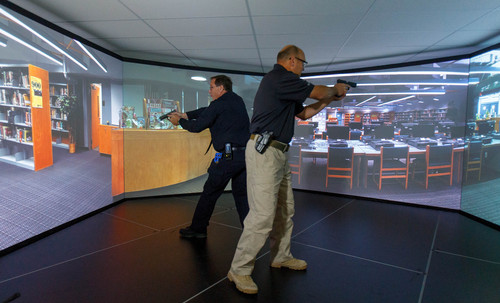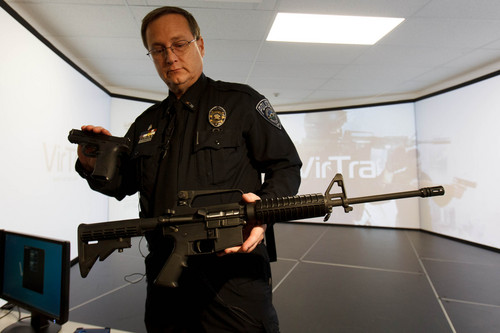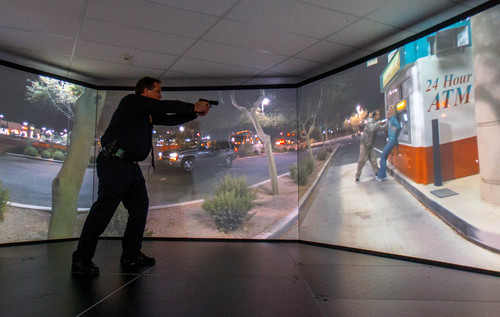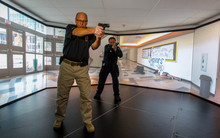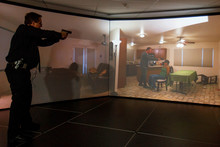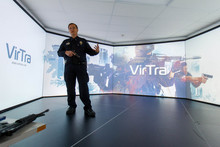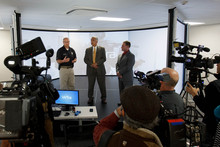This is an archived article that was published on sltrib.com in 2013, and information in the article may be outdated. It is provided only for personal research purposes and may not be reprinted.
Parleys Canyon • The lights dimmed, then the sound system filled the room with the voice of a dispatcher describing a situation police never want to encounter but all too often do: Reports of shots fired in a school.
Suddenly, video screens lit up on three sides of the two "responding officers" — Unified Police Department (UPD) shooting range master Nick Roberts and Deputy Chief Shane Hudson — putting them at the school's front door.
With the aid of a training programmer, who manipulated the visual scene unfolding before the officers as they moved slowly through virtual hallways, past classrooms and into the library, the cops looked left, right and center.
They talked to each other. They talked to the dispatcher through radios on their chests. In the end, they shot two suspects and did not kill any innocent students who periodically popped into view from behind desks or open doors.
While officers never want to see a tragic scenario like this, the results are likely to turn out much better if they see it for the first time through the county's new training simulator, rather than in real life.
"The officers will know better how to negotiate that space," said County District Attorney Sim Gill, who teamed with Sheriff Jim Winder (also the UPD boss) to lead the charge to acquire the V-300, a five-screen, use-of-force simulator built by VirTra of Tempe, Ariz.
In June, the County Council authorized Gill to transfer $225,000 within his budget to pay the final half of the $451,000 price tag for the simulator and its space on the second floor of the gun range's administrative office.
"It's cutting edge and we need it," said County Council Chairman Steve DeBry, also a UPD captain.
The simulator is now in place at the Salt Lake County Sheriff's shooting range in Parleys Canyon, available for use by officers from around the county and beyond.
"I think we'll have people coming from statewide, if not the Intermountain West, because it's that good," Roberts said in pitching the simulator to the council. "Officers walk into a situation so lifelike … that people in the community and officers will be safer."
He noted that officers can look over their responses to simulator situations and learn where they may have faltered, a potentially deadly mistake in a real confrontation.
After the school-shooting scenario, for instance, Hudson recognized he erred "in getting target-locked on something in front of me" and did not look to the right at one point, exposing himself and his partner to danger. "Next time, I'll make sure I scan the whole room before I go in."
Gill said the simulator will help officers deal with volatile circumstances and, hopefully, reduce officer-involved shootings. In addition to the tragic loss of life or injury, those can be expensive, Roberts told the council, noting the average payout to families of people wrongfully shot by police is $5.4 million.
Having investigated numerous officer-involved shootings, Gill said the simulator will prepare police for "dynamic situations where officers have to act quickly."
"The integrity of the process is driven by our commitment to training," he added. "The goal here is ultimately to stop paying lip service [to training officers] and investing in them the way we need to."
Twitter: @strlibmikeg


